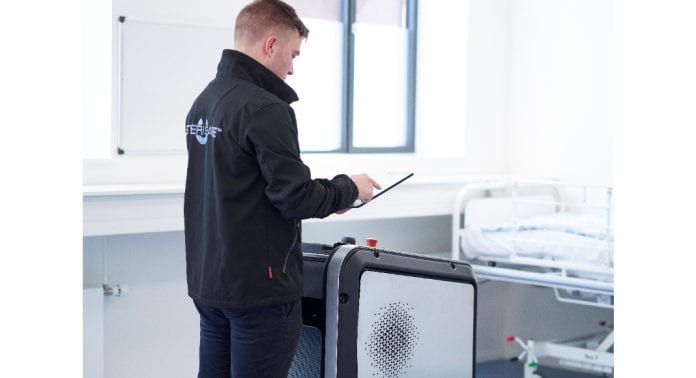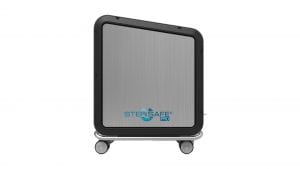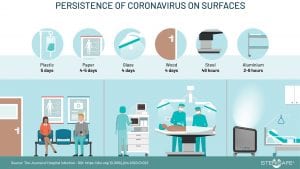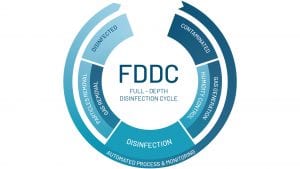
STERISAFE deploys the most advanced ozone technology for room decontamination and surface disinfection.
Though discussions regarding ozone as a disinfection method may seem relatively new, the discovery actually dates back to 1785, when the Dutch chemist Martinus van Marum was managing various experiments. According to van Marum’s statements, he noticed an unusual smell, which he credited to electrical reactions. 50 years later, Christian Friedrich Schönbein noticed the same pungent odour and recognised it as the characteristic smell which occurs after a thunderstorm. Schönbein managed to isolate the gaseous chemical and named it ‘ozone’, which means ‘to smell’ in Greek.
Since then, ozone has been used in many industries, often for purposes related to disinfection. Ozone is one of the most potent disinfectants and is 50 times more powerful than chlorine, which is commonly used in hospitals and other critical areas. Nevertheless, the process of drawing the optimum benefits from this highly useful resource has become a challenge; and various producers have failed to deliver an ozone disinfection solution which is both safe and highly functional.
STERISAFE is currently the most advanced company for ozone-based room disinfection
Contracting methicillin-resistant Staphylococcus aureus (MRSA), COVID-19, or other bacterial infections while in hospital is a substantial risk for patients. When discussing or planning an infection control programme, the course of action is often based on the five pillars of infection prevention:
• Isolation and barrier precautions
• Decontamination of equipment
• Prudent use of antibiotics
• Handwashing
• Decontamination of the environment
The first four pillars are procedures which can be handled individually, as they are methods which most adults can quickly master without further assistance. During the global pandemic, isolation measures, decontamination of equipment, handwashing and sanitising have become integrated into our daily lives. However, there is a significant gap in the practice of environmental decontamination. We are all aware of its importance, yet it seems that access and knowledge regarding the best solutions for decontamination of indoor environments have not been accessible – until now.

Ozone and humidity: not a secret
The synergistic effect between ozone and relative humidity has been documented for a long time. The first study to report the relationship between the two was conducted in 1942: its authors, Elford and Ende, found out that at high relative humidity (RH) levels, even a low concentration of ozone had a noticeable germicidal effect on airborne microorganisms. On the other hand, at less than 45% RH, no biocidal effect could be detected. This dependency was later confirmed by Guerin (1963), which concluded that ozone sterilisation was only efficient on sufficiently hydrated cells; desiccated microorganisms were significantly more resistant to ozone treatment.
More recently, a 2020 study illustrated the dependency between relative humidity, treatment time, and efficacy on airborne viruses’ activity. At fixed ozone concentration greater than 1.5 parts per million (ppm), the tested microorganisms’ infection ratio dipped down considerably with higher RH. Inversely, in dry conditions, the infection rate was unchanged compared to untreated conditions. Logically, longer treatment times also coincided with a higher loss of activity. These findings are particularly relevant in current times, where new information about the propagation of the novel coronavirus pandemic strongly suggests it relies primarily on airborne transmission.
As the dependency of ozone on high humidity levels has been documented for several decades, it is surprising how unscrupulous manufacturers of household ozone generators simply ignore this fact. It is not uncommon to see ozone-based products with no humidity-modifying technology advertised under vague terms, which suggest a strong antimicrobial effect.
The reasons behind the significance of humidity in the ozone-based disinfection process are twofold. First is the physical factor: higher humidity levels enable the rehydration of desiccated pathogens, which decrease their resistance to ozone. Water also tends to form a thin layer around biological material such as bacteria and viruses; in terms of surface disinfection, this permits for the creation of broader surface contact between target pathogens and the ozone.
The second reason as to why humidity is such a deciding factor for ozone biocidal efficacy is as follows: from a chemical standpoint, in the presence of water, the destructive action of ozone can take place either by direct action or through reaction intermediates called radical species. Because molecular ozone is so reactive, it can also react with water and form transient radical species, which are incredibly short-lived but highly reactive. Like ozone, those species exhibit high oxidative power and can, in turn, react with and deactivate harmful pathogens such as bacteria, viruses, fungi, and yeasts.
As ozone and radical species can and will react differently, pathogen deactivation via oxidative damage can occur through several mechanisms. It is generally agreed that the most common target for ozone-driven reactions is the bacterial cell wall, which is composed of unsaturated lipids, amongst others. By damaging those components, ozone and radical species can cause the cell wall to crumble, leading to the targeted cell bursting (cell lysis). Another potential target for ozone and radical species is the genetic material without which bacterial and viral cells cannot survive and reproduce.

Why is STERISAFE so effective against coronaviruses?
The coronavirus can survive on surfaces for multiple days while remaining infectious. On average, the virus is active for between four and five days on surfaces including tables counters, door handles and bed frames, consequently spreading the virus despite sanitisation with a cloth, chlorine, and other traditional remedies.
Since there is no specific remedy against coronaviruses, the prevention of infections is essential. This brings us back to the importance of the decontamination of environments. Like all droplet infections, the virus spreads through surfaces which are touched regularly. In hospitals, this could be doorknobs, bells, bedside tables, bed frames, and other objects in patients’ immediate vicinity. According to one estimation, around 80% of all diseases are spread through direct contact with contaminated surfaces. There are innumerable things in your workplaces that you touch every day which render you more prone to various kinds of illnesses unknowingly.
STERISAFE has performed several efficacy tests by third-party laboratories following the AFNOR NFT 72-281 protocol, which is the only testing standard demonstrating the efficacy of room disinfection procedures. The STERISAFE PRO has demonstrated efficacy of more than 99.99% removal for adenovirus, murine norovirus (MNV), Modified Vaccinia virus Ankara (MVA), and the SV40polyomavirus. These are surrogate and standard test viruses used to document efficacy for enveloped viruses similar to the coronavirus.
STERISAFE PRO
STERISAFE PRO comprises full-depth disinfection cycle (FDDC) technology in a mobile unit for the disinfection of rooms and buildings contaminated with viruses, bacteria, fungi, and spores.
The STERISAFE PRO is easily moved from room to room to perform quick and safe whole-room disinfection. Once the unit is wheeled into the room, the disinfection process can be launched remotely using the equipped tablet. The process is then fully automatic and monitored; and will alert the user once the room is disinfected and safe to enter.
After the disinfection, the STERISAFE PRO reverses its process, turning residual oxidants back into pure oxygen while also removing all particles and nanoparticles. It is then entirely safe to enter and use the room again without the need to wear a protective mask or open the windows. The STERISAFE PRO leaves no residual compounds or harmful byproducts.
It does not use any consumables, as it produces the oxidant (ozone) from ambient air.
When oxidising bacteria, viruses, and general pollution in the air, a byproduct is created consisting of microscopic particles which can be carcinogenic; unlike other whole-room sterilisation solutions, the STERISAFE PRO removes the harmful particles together with all other residues remaining in the room after the disinfection phase.
The STERISAFE PRO:
• Kills up to 99.9999% of all bacteria and viruses
• Leaves no chemical residue
• Emits no harmful byproducts
• Is mobile, flexible, and easy to use
• Offers a fully monitored process
• Needs no additives, as it consumes only water and electricity
The STERISAFE PRO has already proven to be a successful tool within healthcare, hotel, and other crucial indoor environments. The STERISAFE PRO is currently distributed in Europe, Asia, Latin America, and The Middle East; and an expansion into the US market is in the works.
Understanding the differences between UV and ozone
Ultraviolet (UV) light is a part of the light spectrum invisible to the human eye. It is typically categorised in three types depending on the wavelength range: UVA, UVB, and UVC. The only type used for biocidal purposes is the UVC light (200-280 nm), which is known to cause cellular damage at the DNA or RNA level, causing the inactivation of microorganisms.
Additionally, UVC is known to be able to oxidise other cellular targets such as cell walls. UVC light can be produced through various means and types of light bulbs, which differ in their intensity, emission type (for instance, continuous or pulsed emissions), and ultimately in their efficacy. UV technology’s light-based action causes an evident shortcoming: it cannot disinfect areas it cannot ‘see’. This is called the ‘shadow effect’, where, as opposed to gas-based solutions such as ozonation, a UV device will never be able to disinfect all the cracks and corners of a room. While this is the main and most obvious disadvantage of the technology, other drawbacks exist which also could be of valid concern. These concerns are mainly tied to the mode of action of UV light, which efficacy is highly dependent on:
• The intensity and dose of the UV light
• The distance between the light source and the surface to decontaminate
• Exposure time
These three factors are inevitably linked: a shorter distance between the light source and the target surface will provide higher intensity, but will also treat a smaller surface area; and the time needed for full exposure will consequently have to be considered for all treated surfaces. Thus, it is of utmost importance to make sure that UV light-based disinfection systems are appropriately used to ensure adequate disinfection. Correct monitoring of the critical parameters (distance to target surfaces, exposure time for all surfaces) is crucial during the process: with STERISAFE PRO, the integrated ozone and humidity detectors provide this constant, real-time monitoring.
Most serious companies will have conducted third-party efficacy tests to validate their claims, but this is not yet a legal requirement at the European level; as under most circumstances, UV light does not fall under the Biocidal Product Regulation (BPR) – and the controlled conditions of such tests are near impossible to replicate in real-life scenarios.
UV as a surface disinfectant
More particularly, claims regarding the efficacy of UV disinfection are based on the results of tests conducted at a fixed distance (typically 30cm, 50cm, or 1m). However, as light obeys an inverse square law, the intensity of UV rays will drop exponentially with increasing distance. This means that, when the distance between the light and the target surface doubles, only a quarter of the original intensity reaches the target surface. The loss of intensity incurs a commensurate loss of biocidal efficacy; as such, manufacturers typically advertise log reduction ranging between two and four, a far cry from the log six reduction which can be seen in other technologies. Additionally, static UV light systems must be placed at three or four different positions within a room to eliminate shadows and therefore ensure a somewhat proper covering of the surfaces. This means that, while a single cycle time for UV disinfection typically takes around 15 minutes, the total cycle time for a single room must be multiplied by the number of different positions.
In addition to the shortcomings associated with being a light source, UV-based technology shares some issues with other types of disinfection. Manufacturers of UV light devices often claim that UV radiation does not generate direct byproducts; however, reacting with UVC light may cause products to form or change, depending on the types of compounds already present in the room. Some organic compounds partially oxidise in the presence of UV light, producing what are known as Disinfection Byproducts (DBPs). This includes gaseous compounds such as formaldehyde, benzaldehyde, acetic acid, acetaldehyde, formic acid, and carbon monoxide. Fine particulate, similar to the smog pollution seen in dense urban areas, may also be formed. Particulate and gaseous species are responsible for what is known as Sick Building Syndrome (SBS) which is responsible for headaches, sluggish work performance, lack of concentration, and increased sick days for workers.
The production of these harmful compounds is most clearly indicated by the residual smell of burned particles of hair or skin which is sometimes present after a UV-based treatment. Depending on the initial conditions, the intensity of the odour can be strong enough to cause some discomfort on the part of nearby workers. It is important to note that virtually all disinfectants, including ozone, possess the potential to react with organic compounds initially present on a treated surface or in the air. However, STERISAFE PRO is equipped with an electrostatic precipitator (ESP) to filter out those particle residues and reduce them, along with some gaseous species, to safe levels; to our knowledge, no UV-based disinfection technology can offer this feature. Moreover, as is the case with virtually every biocide, what is harmful to microorganisms will also be harmful to humans. UVC light can penetrate the skin and thus potentially cause damage to the skin and retinas of anyone exposed to it. Different types of UVC can have different consequences or variable dangers, so it is important to know the safety measures associated with the technology.
The basics
As is the case with ozone or hydrogen peroxide, UV-based disinfection technology presents both its own advantages and disadvantages; and when it comes to choosing a solution, it is important to be aware of the particularities of each technology. Compared to its competitors, UV light has the edge in terms of both treatment time and ease of use, specifically with regards to room preparation. However, the STERISAFE PRO and its ozone-based technology will always boast much more reliable results due to its constant, real-time monitoring of its biocidal parameters and a guarantee that virtually every surface is treated equally within a treated room.
STERISAFE and FDCC technology
FDDC is the only technology to apply a full air purification process following biological disinfection. This process removes all the remaining oxidant gases, as well as the harmful byproducts such as particles and nanoparticles; meaning the room can be re-entered shortly after the disinfection cycle is complete. Comparatively, all other disinfection solutions leave residual gases and harmful particles.
The three phases of FDDC are as follows:
• Buildup: biocide ozone (O¬3) gas is generated in situ and is widely diffused throughout the room – the user retains full control of concentration and humidity levels
• Disinfection: high gas concentration and high humidity are maintained and spread to all cracks and corners
• Purification: all remaining biocide gas is actively removed and converted to oxygen, while all residual particles and nanoparticles are extracted from the air. Parameters are closely monitored to guarantee safety at re-entry
STERISAFE PRO’s fully automated FDDC solution provides a complete disinfecting solution, from the generation of biocidal agent, the disinfection itself, and the removal of both the active agent and potentially harmful compounds. With STERISAFE PRO, there is no need for external products or additional material, further ensuring a safe environment for employees and anyone involved in the disinfection process. By constantly monitoring the RH and O3 values and ensuring that every single disinfection cycle is conducted appropriately, STERISAFE PRO guarantees the efficacy of its biocidal process. Combining high humidity levels with ozone ensures that a suitable environment is created wherein ozone is able to trigger a cascade reaction which includes reactive radical species, giving ideal parameters for the complete inactivation of harmful microorganisms present in the treated room.

Preparing for the future
At STERISAFE we are continuously developing our product line and technology to include the latest technical innovations and bring more value to users. The vision is to bring the Industry 4.0 drivers – automation; safety; data; cloud technology; smart sensors; Artificial Intelligence (AI); and Internet of Things (IoT) – to environmental hygiene.
The protocolisation and management of all disinfection processes will allow hygiene staff to monitor and document all disinfection processes centrally, even in larger groups where many sites are under the same administration. By tracking cycles and monitoring the data, the management team can take preventive measures to prevent minor and major outbreaks.
Amanda Johnsen
Marketing and Sales Assistant
Sorivan Chhem-Kieth
Product Manager – STERISAFE PRO
STERISAFE ApS
www.sterisafe.eu
This article is from issue 15 of Health Europa. Click here to get your free subscription today.
























